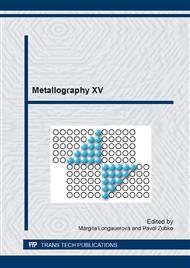p.398
p.404
p.408
p.415
p.421
p.427
p.431
p.437
p.441
Free Machining Brasses with Minimized Lead Content
Abstract:
Last 15 years is in the sign of increasing pressure on decreasing of content of toxic metals in consumer products. Widely known are legislative rules on decreasing the content of cadmium, hexavalent chromium and mercury in various products for their negative effect on environment and human health. Similar legislative acts take care of lead content in free machined brass. For example rules that come from directive of European Council 98/83/ES released on November the 3rd 1998 command, that maximum content of lead in brass products which are in contact with drinking water has to be less than 1%. Similar and stronger rules are applied in California by the law AB 1953 which reduces the lead content in these brass products under 0,25 %. Article describes the role of lead in free machining brass and describes the problems of its substitution by means of other elements and phases for bringing similar machinability as in case of brass with lead. Article also introduces experiments with melting of new brass with substitution of lead. Microstructures of experimental heats are shown and further experiments are described.
Info:
Periodical:
Pages:
421-426
Citation:
Online since:
April 2014
Authors:
Keywords:
Price:
Сopyright:
© 2014 Trans Tech Publications Ltd. All Rights Reserved
Share:
Citation:


